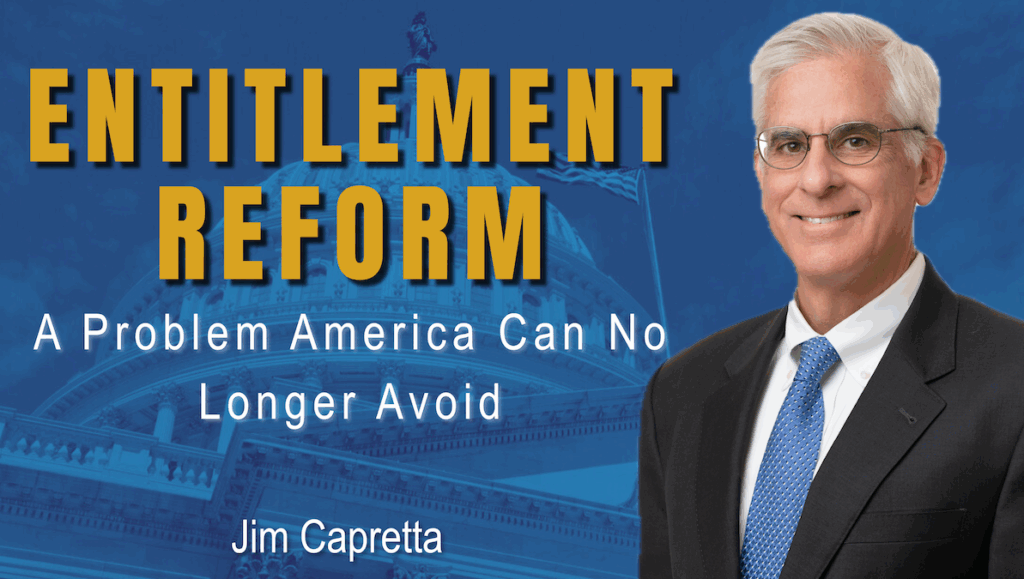Entitlement Reform: A Problem America Can No Longer Avoid
November 5, 2025

Join The American Idea’s Listener Email list – get news about upcoming episodes and a chance to offer questions for them, too!
The clock is ticking on America’s most popular social programs. Social Security’s trust fund is projected to be depleted by 2034—just nine years away—leaving the system with enough revenue to pay only 75% of promised benefits. Medicare faces a similar reckoning by 2033. Yet despite decades of warnings, neither political party has mustered the will to enact meaningful reforms. Read on for more from the American Enterprise Institute‘s James Capretta, this week’s guest on The American Idea.
The Historical Foundation
America’s entitlement system has its roots in early 20th-century Europe, where countries like Germany under Bismarck first established government-backed retirement programs. The concept arrived in the United States during the Great Depression, when President Franklin D. Roosevelt championed the Social Security Act of 1935. The law created automatic government benefits for those meeting specific eligibility criteria, covering retirement, unemployment compensation, and welfare support.
Roosevelt designed the system brilliantly from a political standpoint. By establishing a “trust fund” and requiring visible payroll deductions, known as FICA taxes, he created a direct psychological connection between workers’ contributions and their future benefits, indirectly promoting the long-held fallacy that Social Security is akin to commercial insurance, with individual accounts for each person. This made the program politically untouchable, as he well understood.
The system expanded dramatically in 1965 when President Lyndon Johnson signed Medicare and Medicaid into law. Medicare, modeled after Social Security’s success, provided healthcare coverage for retirees. Medicaid created a federal-state partnership to cover low-income Americans. Together, these programs completed the architecture of America’s modern welfare state.
How the System Actually Works
Contrary to popular belief, Social Security does not operate like a personal retirement account. Workers’ payroll taxes don’t go into individual investment accounts that grow over time. Instead, the system operates on a pay-as-you-go basis: today’s workers fund today’s retirees, and future workers will fund today’s workers when they retire.
Benefits are calculated using a complex formula based on a worker’s 35 highest-earning years, adjusted for inflation and run through a progressive bracket system. Lower-wage workers receive 90% return on their first earnings tranche, while higher earners receive only 15% on their top earnings. The system includes spousal and survivor benefits, making it a hybrid of insurance and social welfare rather than a pure retirement savings program.
The Demographic Time Bomb
The system’s troubles began emerging in the mid-1970s when two seismic shifts occurred. First, the post-war economic boom ended, replaced by stagflation that shook confidence in perpetual growth. Second, and more critically, the baby boom ended. Birth rates declined, fundamentally altering the ratio of workers to retirees.
In the 1950s and 1960s, Congress had expanded benefits generously, assuming population growth would continue indefinitely. Those assumptions proved disastrously wrong. By the late 1970s, actuaries were sounding alarms that the numbers no longer added up. Major reforms passed in 1977 and 1983 bought time, but never addressed the fundamental structural problems.
Today, the demographic reality is stark: fewer young workers are supporting a growing population of retirees who are living longer than ever. The promised benefits exceed projected revenue by approximately 25%—a gap that represents trillions of dollars over the coming decades.
The Fiscal Consequences
The entitlement crisis doesn’t exist in isolation. It’s part of a broader fiscal challenge that threatens America’s economic future. Federal debt currently equals roughly 130% of GDP, approximately $38 trillion. Without reform, continued borrowing to cover unfunded entitlement promises could push debt to 150% of GDP by mid-century and 200% within several more decades.
Once debt reaches these levels, a dangerous cycle begins. Interest payments consume an ever-larger share of tax revenue, leaving less for everything else government does. The debt compounds on itself, digging a hole that becomes increasingly difficult to escape.
Reform Options and Political Realities
The mathematics of Social Security reform are relatively straightforward. Solutions exist on both the revenue and benefit sides of the equation. On the benefit side, the formula could be made more progressive, reducing payments to higher earners while strengthening the safety net for the poorest seniors. The retirement age could be gradually increased to reflect longer lifespans. Benefits for the very elderly—those 85 and older who face the highest poverty rates—could be enhanced.
On the revenue side, the payroll tax could be modestly increased from its current 12.4% to perhaps 13.4%. The cap on wages subject to Social Security taxes, currently around $175,000-$180,000, could be raised or eliminated for high earners.
More ambitious reforms could fundamentally restructure the system. Personal retirement accounts—where individuals own and invest their contributions directly—would create transparency and a direct link between contributions and benefits. This approach has succeeded in countries like Sweden and Italy, which faced similar demographic challenges and implemented personalized account systems.
International Lessons
America is not alone in confronting entitlement sustainability. Germany, France, the United Kingdom, Japan, Spain, and Italy all face similar demographic pressures from aging populations and declining birth rates. Some, like Italy and Sweden, have undertaken significant reforms decades ago when their situations were even more dire than America’s current predicament.
These countries have demonstrated that reform is possible, but it requires political courage and a willingness to move beyond the traditional pay-as-you-go model toward systems with greater personalization, transparency, and direct connection between contributions and benefits.
The Path Forward
The window for gradual, manageable reform is closing. Every year of delay makes the necessary adjustments more severe. When the trust funds are depleted in the early 2030s, Congress will face an impossible choice: cut benefits by 25%, raise taxes dramatically, or borrow trillions more dollars.
The likeliest outcome, given current political dynamics, is continued procrastination followed by massive borrowing—a choice that pushes the problem onto future generations while accelerating the debt spiral. Neither party currently shows the political will to champion comprehensive reform, despite both having proposed solutions in the past.
Yet America has historically shown a capacity for self-correction when crises loom. The question is whether political leadership will emerge before the crisis becomes a catastrophe, or whether the nation will wait until the trust funds are literally empty before taking action. The answer to that question will determine not just the retirement security of millions of Americans, but the fiscal sustainability of the United States itself.
Do you want to know more? Read James Capretta’s book, U.S. Health Policy and Market Reforms.

